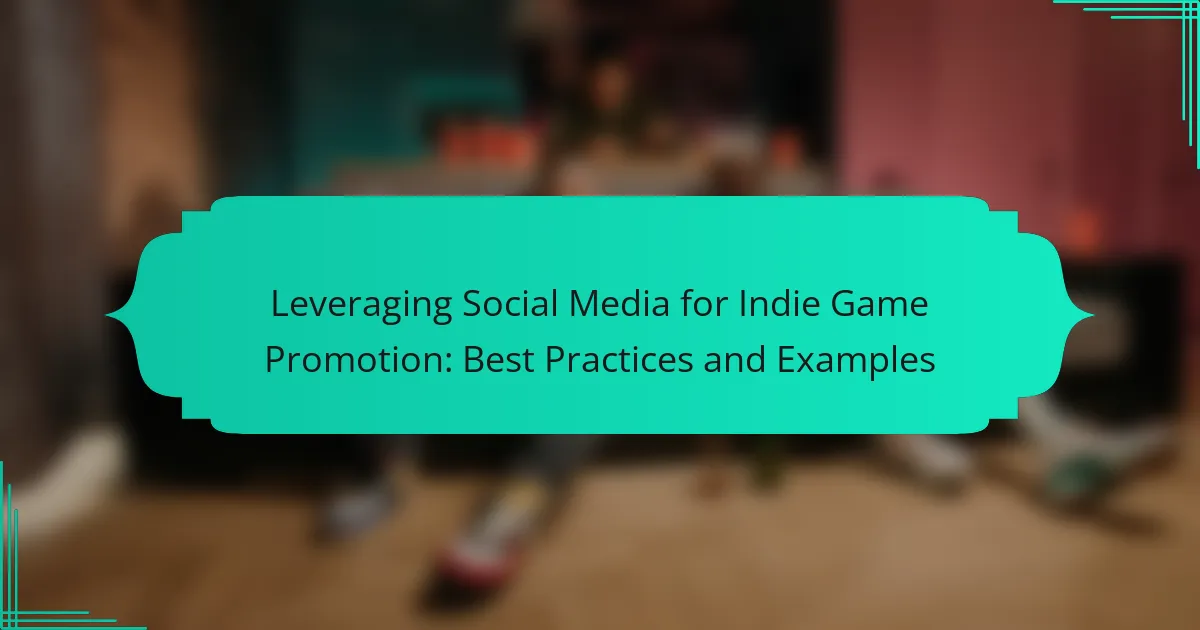Indie game developers often struggle to gain visibility in a crowded market. Leveraging social media can enhance engagement, build community, and showcase unique game attributes. Key strategies include consistent posting, collaboration with influencers, and utilizing analytics for targeted content. By focusing on authentic interactions and user-generated content, developers can foster loyalty and drive player interest.
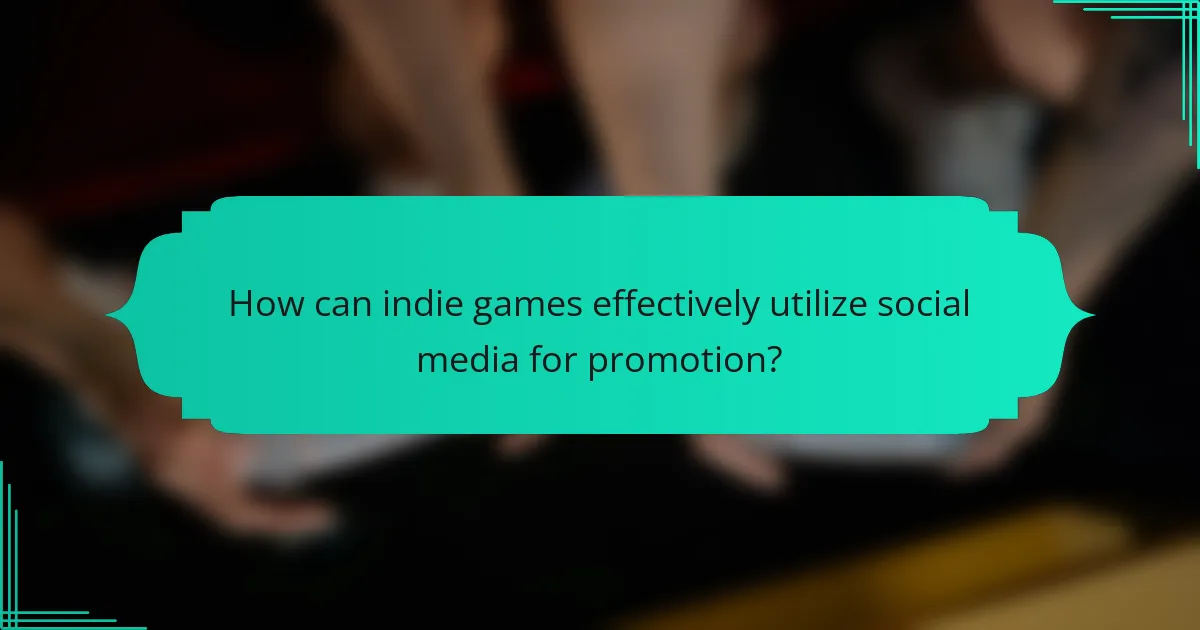
How can indie games effectively utilize social media for promotion?
Indie games can effectively utilize social media for promotion by engaging directly with their audience and creating shareable content. Regular updates, behind-the-scenes insights, and interactive posts can build a community around the game.
Using platforms like Twitter, Instagram, and TikTok allows indie developers to showcase gameplay, art, and development processes. Engaging with followers through polls, Q&A sessions, and live streams can enhance visibility and foster loyalty.
Collaborating with influencers and gaming communities can amplify reach. Unique attributes like distinctive art styles or innovative gameplay mechanics should be highlighted to differentiate the game from competitors.
Incorporating user-generated content encourages players to share their experiences, further promoting the game organically. Consistent branding and messaging across platforms reinforce the game’s identity, making it more memorable to potential players.
Which social media platforms are most beneficial for indie game marketing?
Platforms like Twitter, Instagram, and TikTok are highly beneficial for indie game marketing. They offer unique engagement opportunities and access to diverse audiences. Twitter enables real-time interaction with gamers and industry influencers. Instagram showcases game visuals, attracting potential players through eye-catching content. TikTok’s short-form videos allow creative storytelling and viral marketing potential. Each platform’s distinct features enhance visibility and community building for indie games.
What are the key demographics of gamers on social media?
The key demographics of gamers on social media include a diverse age range, with a significant portion aged 18-34. This group often engages with content across various platforms, such as Facebook, Instagram, and Twitch. Gender representation is becoming more balanced, with nearly 45% of gamers identifying as female. Additionally, gamers frequently share their experiences, forming communities that enhance indie game visibility. Understanding these demographics helps tailor promotional strategies effectively.
How does audience engagement impact indie game visibility?
Audience engagement significantly boosts indie game visibility by fostering community support and increasing organic reach. Engaged players share their experiences, generating buzz that attracts more potential players. For example, social media platforms allow developers to showcase gameplay, receive feedback, and build a loyal fanbase. This interaction enhances discoverability and can lead to higher sales and funding opportunities. Engaging content, such as behind-the-scenes updates or interactive polls, can further deepen connections, making players feel invested in the game’s success.
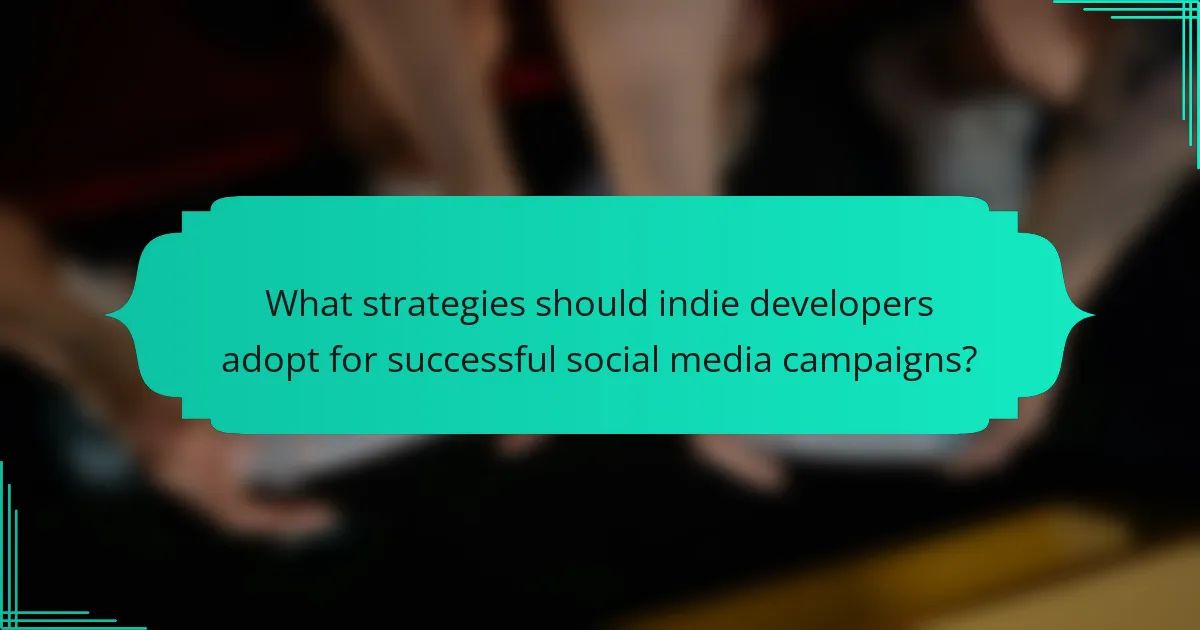
What strategies should indie developers adopt for successful social media campaigns?
Indie developers should focus on authentic engagement, targeted content, and community building for successful social media campaigns. Establish a strong brand voice to connect with your audience. Utilize platforms like Twitter, Instagram, and TikTok to share behind-the-scenes content, game updates, and interactive posts. Collaborate with influencers and other developers to expand reach. Analyze metrics to refine strategies and understand audience preferences. Consistency in posting and responding to feedback enhances visibility and fosters loyalty.
How can storytelling enhance the appeal of an indie game on social media?
Storytelling enhances the appeal of an indie game on social media by creating emotional connections with potential players. Engaging narratives can capture attention, foster community, and encourage sharing. Unique storylines differentiate games, making them memorable. Incorporating behind-the-scenes content or character development can deepen audience interest and drive interactions. Additionally, sharing player stories can enhance authenticity and build a loyal fan base.
What role do visuals and trailers play in social media promotion?
Visuals and trailers are crucial for engaging audiences on social media. They capture attention quickly, convey the game’s essence, and stimulate interest. High-quality visuals can enhance brand identity and create shareable content, increasing visibility. Trailers provide a narrative glimpse into gameplay, setting expectations and fostering emotional connections. These elements, when used effectively, can significantly boost an indie game’s reach and community engagement.
How can indie developers leverage influencer partnerships effectively?
Indie developers can effectively leverage influencer partnerships by selecting influencers whose audience aligns with their game’s target demographic. Building authentic relationships with influencers fosters genuine promotion, as they can create engaging content that resonates with their followers.
Offering exclusive access to game content or early demos enhances the partnership’s value, encouraging influencers to share their experiences. Tracking engagement metrics helps developers assess the effectiveness of these partnerships, informing future strategies.
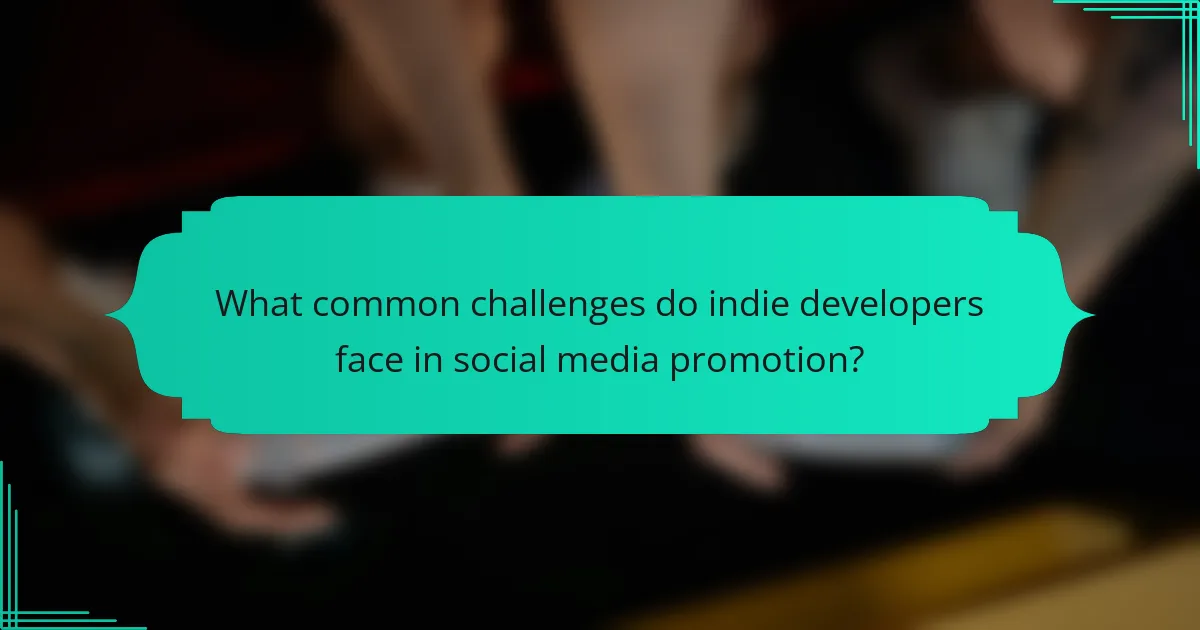
What common challenges do indie developers face in social media promotion?
Indie developers face several common challenges in social media promotion. Limited budgets restrict advertising options, making organic reach crucial. Time constraints hinder consistent content creation, affecting engagement. Competition from larger studios overshadows visibility, complicating audience growth. Additionally, navigating platform algorithms can be complex, leading to ineffective strategies. Understanding audience preferences is essential but often difficult for indie developers.
How can limited budgets impact social media marketing strategies?
Limited budgets can significantly restrict social media marketing strategies for indie game promotion. Resource constraints often lead to reduced ad spend, limiting reach and engagement. Consequently, indie developers may need to focus on organic growth strategies, such as community building and content creation, to maximize their impact. Utilizing platforms like Twitter and Discord can foster direct connections with potential players, enhancing visibility without high costs. Additionally, collaborations with influencers can provide cost-effective promotion, leveraging their established audiences to boost game awareness.
What are the risks of negative feedback on social media?
Negative feedback on social media can significantly harm indie game promotion. It can damage brand reputation, deter potential players, and reduce community engagement. Negative comments may lead to a perception of poor quality or lack of support, which can discourage sales. Additionally, the viral nature of social media can amplify criticism, making it crucial for developers to manage feedback proactively. Engaging positively with criticism can mitigate these risks and foster a supportive community.
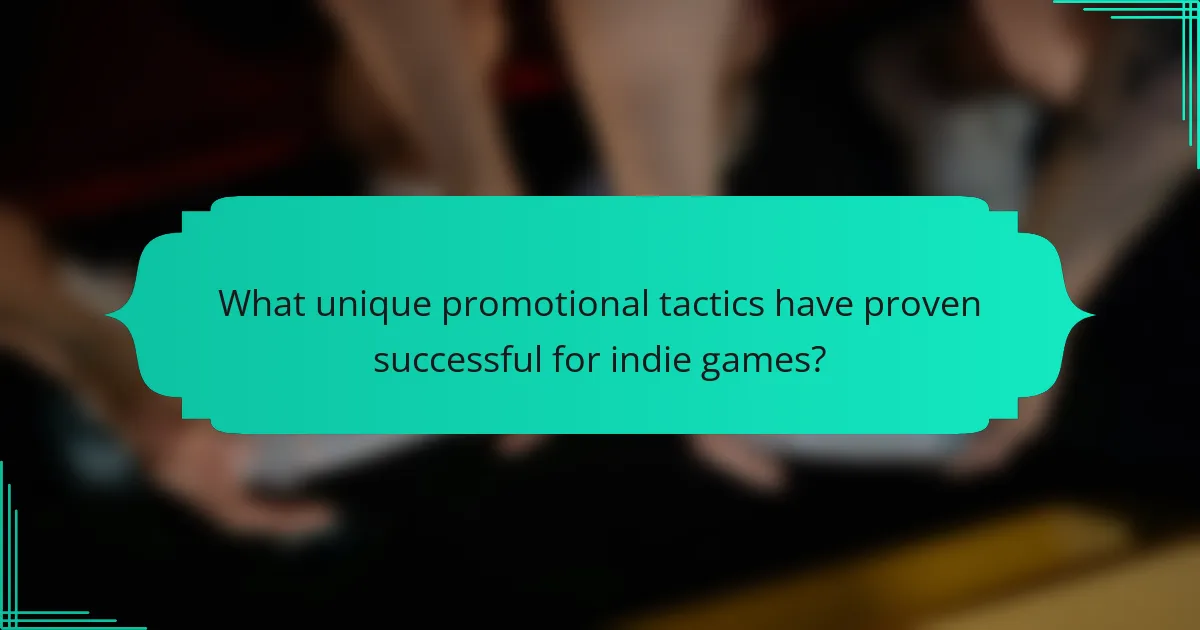
What unique promotional tactics have proven successful for indie games?
Indie games have successfully leveraged unique promotional tactics by utilizing social media platforms effectively. Engaging directly with communities on platforms like Twitter, Discord, and Instagram fosters genuine connections with potential players.
Indie developers often share behind-the-scenes content, such as development updates and art showcases, which creates anticipation and interest. Collaborating with influencers and streamers allows for wider reach and authentic gameplay demonstrations.
Participating in online events, like game jams and showcases, enhances visibility and provides networking opportunities. Additionally, running targeted ad campaigns on social media can effectively reach niche audiences interested in indie gaming.
Using user-generated content, such as fan art or testimonials, builds community engagement and loyalty. These tactics collectively enhance brand recognition and player involvement, essential for indie game success.
How can game jams and community events boost visibility on social media?
Game jams and community events significantly enhance visibility on social media by fostering engagement and generating buzz. These gatherings create opportunities for developers to showcase their work, connect with audiences, and share experiences.
Participating in game jams allows indie developers to produce unique content quickly, leading to shareable moments that resonate with fans. Social media platforms thrive on fresh, engaging content, making these events ideal for attracting attention.
Moreover, community events often involve collaboration and competition, encouraging participants to share their progress and results online. This shared experience amplifies reach, as attendees and spectators alike promote their favorites, creating a ripple effect of visibility.
Finally, leveraging hashtags and live updates during these events can help capture a broader audience. Engaging with followers in real-time builds a sense of community and encourages further sharing, increasing overall exposure for indie games.
What innovative use of user-generated content can enhance marketing efforts?
User-generated content enhances marketing efforts by fostering community engagement and authenticity. Encouraging players to share gameplay experiences, fan art, or reviews creates a sense of ownership and connection. For instance, featuring user-generated trailers or testimonials on social media amplifies reach and builds trust. Brands like “Among Us” effectively utilized fan art and memes, driving organic promotion and community growth. This approach not only diversifies content but also strengthens brand loyalty among indie game enthusiasts.
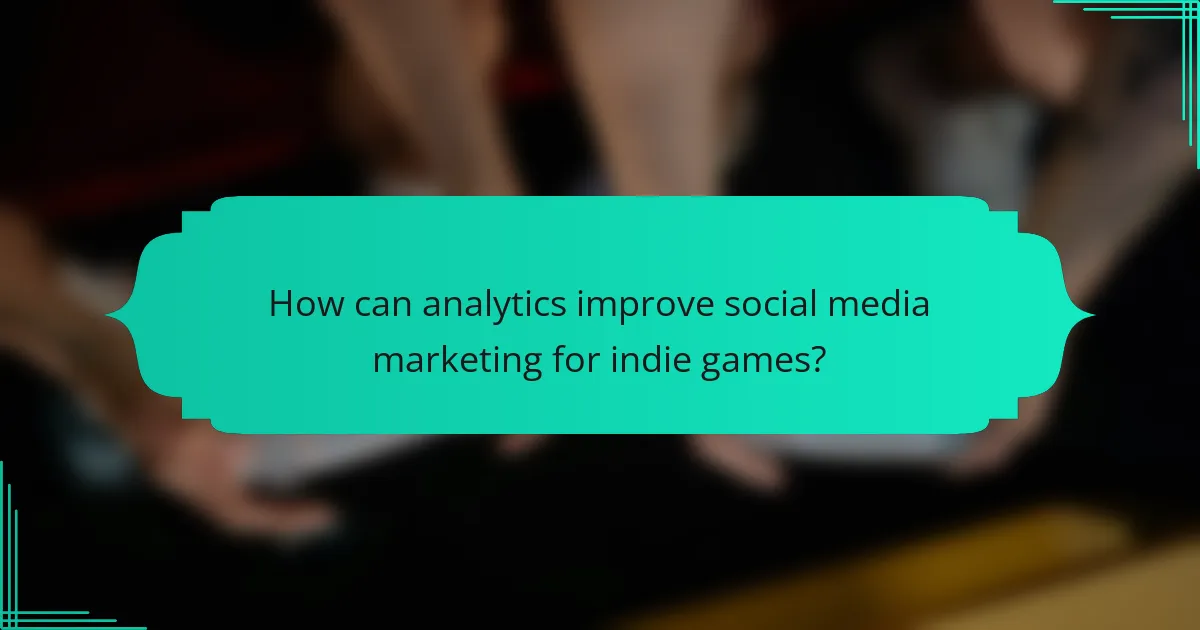
How can analytics improve social media marketing for indie games?
Analytics significantly enhances social media marketing for indie games by providing data-driven insights. By analyzing user engagement, developers can tailor their content to resonate with their audience. Metrics such as likes, shares, and comments reveal which posts generate interest.
Furthermore, tracking audience demographics helps indie game developers identify their target market. This allows for focused advertising and community building. For example, understanding peak engagement times enables strategic posting to maximize visibility.
Utilizing analytics tools can also uncover trends in player preferences. This data can guide game development and marketing strategies, ensuring alignment with audience expectations. As a result, indie games can achieve greater visibility and player engagement, ultimately driving sales.
What metrics should indie developers track to measure campaign success?
Indie developers should track engagement metrics, conversion rates, and audience growth to measure campaign success. Engagement metrics include likes, shares, and comments, indicating how well content resonates. Conversion rates reflect the effectiveness of calls to action, while audience growth shows overall reach and brand awareness. Additionally, monitoring retention rates helps understand player loyalty post-launch.
How can A/B testing refine social media strategies?
A/B testing can significantly refine social media strategies by providing data-driven insights into audience preferences. By comparing different content formats, messaging, or posting times, developers can identify what resonates best with their target audience. This process enhances engagement rates and optimizes promotional efforts for indie games. For instance, testing visuals versus text-based posts can reveal which garners more interaction. As a result, indie game marketers can allocate resources more effectively, ensuring higher returns on investment.
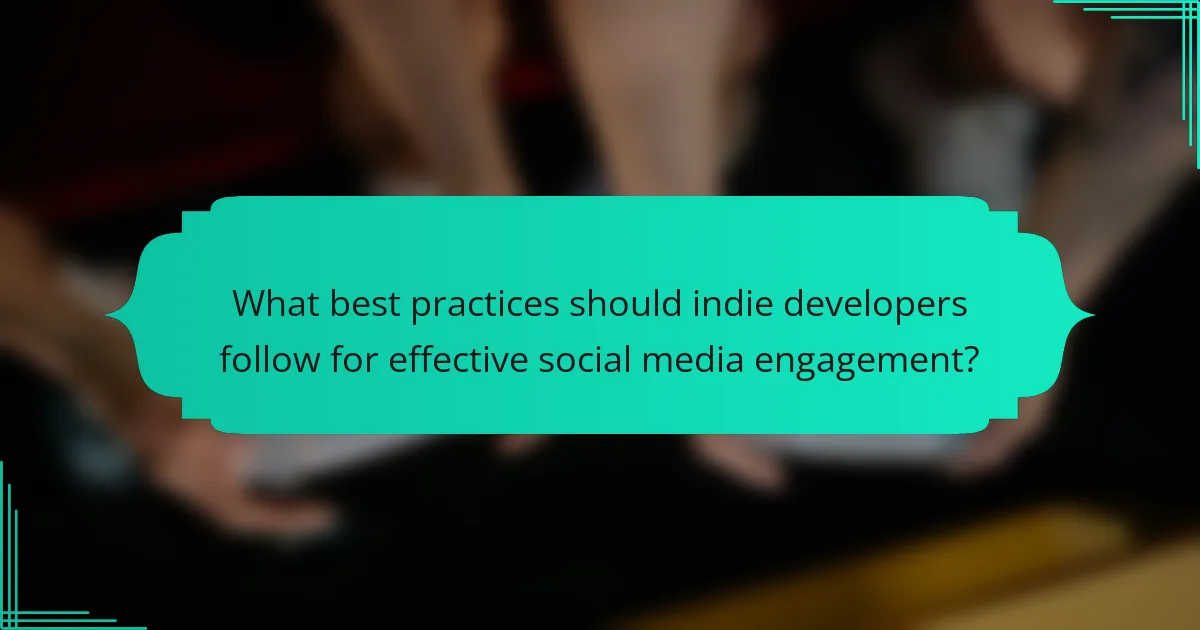
What best practices should indie developers follow for effective social media engagement?
Indie developers should prioritize authentic engagement, consistent posting, and community interaction for effective social media promotion. Building a genuine connection with followers enhances brand loyalty and visibility. Utilize visuals and gameplay videos to showcase the game’s unique attributes, attracting potential players. Collaborate with influencers to expand reach and credibility, while actively participating in relevant discussions to establish authority in the gaming community.
What are the common mistakes to avoid in indie game social media promotion?
To effectively promote an indie game on social media, avoid these common mistakes: neglecting audience engagement, inconsistent branding, failing to analyze metrics, and over-promoting. Engaging with your audience builds community, while consistent branding strengthens recognition. Analyzing metrics helps refine strategies, and balanced promotion prevents audience fatigue.
How can indie developers maintain a consistent brand voice across platforms?
Indie developers can maintain a consistent brand voice across platforms by defining core messaging and visual identity. Establish clear guidelines for tone, style, and imagery. Engage with audiences authentically and adapt messages to fit platform nuances while remaining true to the brand ethos. Regularly analyze audience feedback to refine voice consistency.
Which tools can assist in managing social media campaigns effectively?
Utilizing effective tools can significantly enhance the management of social media campaigns for indie game promotion. Key tools include Hootsuite for scheduling posts, Canva for creating engaging visuals, and Google Analytics for tracking performance metrics. These tools streamline content creation, optimize engagement, and provide valuable insights into audience behavior.
What expert tips can enhance social media outreach for indie games?
To enhance social media outreach for indie games, focus on authentic engagement and strategic content sharing. Build a community by interacting with followers and responding to feedback. Utilize visually appealing content, like gameplay videos and behind-the-scenes insights, to capture attention. Collaborate with influencers to expand reach and leverage their audiences. Analyze metrics to refine strategies and understand what resonates with players.
